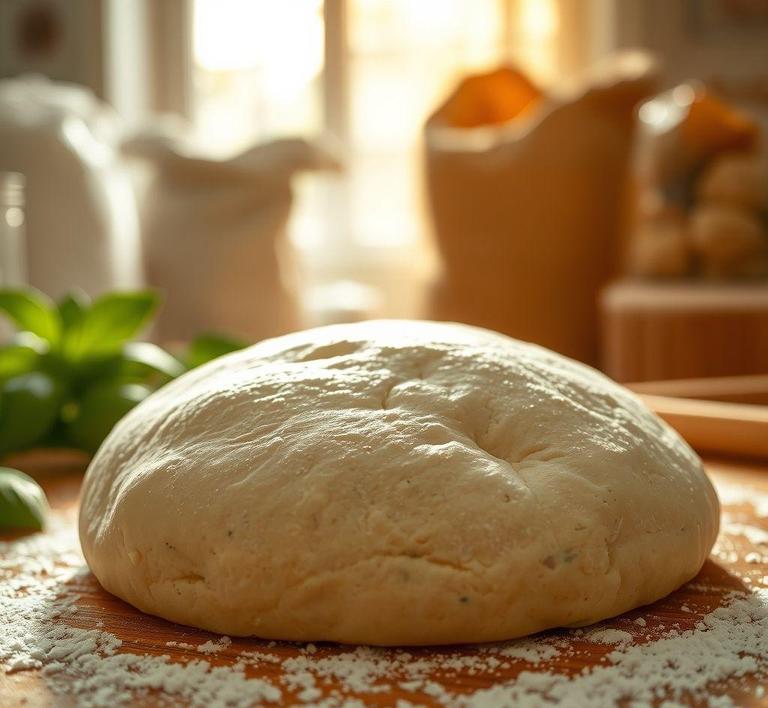If you’ve ever made pizza dough and ended up with leftovers, you might be wondering whether it’s okay to refreeze it for future use. The good news is, yes, you can refreeze pizza dough, but there are a few important things to keep in mind to ensure it stays fresh and tasty. Whether you’re prepping dough in advance or just want to save some for later, learning how to properly freeze and refreeze pizza dough can help you save time and avoid waste. In this guide, we’ll walk you through the best methods to refreeze your dough, so it rises perfectly when you’re ready to bake your next pizza!
Can You Refreeze Pizza Dough?

Refreezing pizza dough is one of those kitchen questions that can divide opinions, especially when it comes to preserving the taste and texture of the dough after it has been previously frozen. The short answer is: Yes, you can refreeze pizza dough, but with some important caveats. The decision to refreeze pizza dough is often influenced by how the dough has been handled in the first place, as well as how it is stored and thawed.
Pizza dough is made up of simple ingredients-flour, water, yeast, and salt-each of which reacts differently to freezing and thawing. Freezing works by slowing down the fermentation process, allowing the dough to be preserved for weeks or even months. The yeast within the dough remains dormant during freezing, and once the dough is thawed, the yeast "wakes up" and begins to work again, allowing the dough to rise.
However, when you refreeze pizza dough that has already been thawed and allowed to rise once, the results can be mixed. In fact, the general consensus among pizza makers and home bakers is that while you technically can refreeze pizza dough, it’s often not the best choice if you’re aiming for high-quality results. More on that later, though.
How To Refreeze Pizza Dough?
If you’ve decided to go ahead with refreezing your pizza dough, it’s important to follow the proper steps to minimize any negative impact on the dough’s texture and rise. Here’s how you can do it:
- Thaw the Dough Properly: If the dough has already been frozen once, ensure that it is thawed completely before attempting to refreeze it. You can leave it in the fridge overnight, allowing it to thaw slowly and evenly. Quick thawing at room temperature may cause the dough to lose its integrity or affect the yeast, so patience is key here.
- Portion It First: If you’ve thawed a large batch of pizza dough, consider dividing it into individual portions before refreezing. This will make it much easier to use the dough in smaller quantities without needing to thaw everything each time. Form the portions into small, tight balls or disks that are easy to wrap and store.
- Wrap the Dough: Use plastic wrap, wax paper, or even a resealable plastic bag to wrap the dough portions tightly. This will prevent air from entering and causing freezer burn or moisture loss. If you’re using a resealable bag, try to squeeze out as much air as possible before sealing.
- Freeze Quickly: Once wrapped, place the dough portions in the freezer as quickly as possible. Try not to overcrowd the dough on the shelf, so the dough has enough space to freeze quickly and evenly. Freezing rapidly helps preserve the quality of the dough.
- Label and Date: Don’t forget to label the dough with the date of freezing. Frozen dough can last for up to 3 months, but beyond that, you may start to notice a decrease in quality.
- Thaw Again When Ready to Use: When you’re ready to use the dough again, thaw it in the fridge overnight to ensure it defrosts slowly. Allow it to come to room temperature before using it on your pizza. If the dough looks a little deflated, you can knead it gently for a minute to reactivate some of the yeast before stretching it into your pizza crust.
Quality Impact
When it comes to the quality of refrozen pizza dough, there are a few considerations that are worth noting. Each time you freeze and thaw dough, the structure of the dough changes slightly, primarily due to how the yeast and gluten interact with the cold and thawing processes.
1. Texture: Refreezing pizza dough can result in a slightly denser and less elastic dough, especially if it has gone through multiple freeze-thaw cycles. The gluten, which is responsible for the dough’s ability to stretch, can become less effective, leading to a more brittle or tough texture. The dough may be harder to stretch, and when baked, it might not achieve that light, airy, and chewy texture you expect from a good pizza crust.
2. Yeast Activity: Yeast is a living organism, and while freezing doesn’t kill it, it does put it into a dormant state. Each time the dough is thawed, the yeast "wakes up," and when it is refrozen, it might not have the same vigor to help the dough rise as it would if it were used fresh. This means that the dough might not rise as much, affecting the final crust.
3. Flavor: The flavor of pizza dough is heavily influenced by fermentation, and the freezing and refreezing process can impact the flavor profile. Yeast activity is what contributes to the dough’s subtle, savory taste, and multiple freeze-thaw cycles can reduce the yeast’s effectiveness, leading to a flatter, less flavorful crust. Additionally, any air that gets trapped in the dough during freezing can result in a more stale or freezer-burned taste.
4. Freezer Burn: If the dough isn’t sealed properly, it is susceptible to freezer burn, which can drastically affect its quality. Freezer burn occurs when moisture evaporates from the dough and forms ice crystals, which will cause texture loss and potentially off-flavors. A dough that’s been frozen improperly may also develop unwanted air pockets or uneven moisture, resulting in an inconsistent texture when baked.
5. Increased Risk of Over-proofing: Dough that’s been frozen and thawed, especially if it’s been allowed to rise more than once, may end up over-proofing during baking. This means the dough might rise too much, collapse in on itself, or lose its shape. It’s a delicate balancing act between preserving the dough’s integrity and avoiding this over-proofing effect.
While it is possible to refreeze pizza dough, it’s not always the ideal option if you’re aiming for the best possible pizza quality. Each time you freeze and thaw pizza dough, there’s a chance that the texture, flavor, and yeast activity will degrade to some extent. If you’re in a pinch and need to preserve the dough, proper storage and careful thawing can help mitigate some of these issues, but it’s always best to minimize the number of times dough goes in and out of the freezer.
If you’re really dedicated to preserving your pizza dough for the long haul, consider freezing it as soon as it’s made, before it undergoes its first rise. You can freeze dough at this point, so when you thaw it, the yeast will have the freshest chance to ferment the dough, resulting in a superior texture and flavor. But even in cases where you’ve already thawed and risen your dough once, refreezing it may still be a practical solution for saving leftovers-just don’t expect the same flawless pizza you’d get from fresh dough.
Is It Safe To Refreeze Pizza Dough?
Refreezing pizza dough is a topic that often sparks a lot of debate among home bakers and chefs. The short answer is: it is possible, but it comes with certain caveats. When dough is frozen, its texture and structure undergo changes due to the formation of ice crystals, which can disrupt the gluten network. However, if done properly, refreezing pizza dough can still yield satisfactory results. The key lies in the process and timing.
Pizza dough is typically made from a combination of flour, water, yeast, and salt. These ingredients, when mixed together, create a matrix that holds air bubbles during the fermentation process, contributing to the dough’s rise and texture when baked. Freezing the dough stops fermentation in its tracks, essentially putting it on pause. But when you refreeze pizza dough, the dough’s yeast may not work as effectively the second time around. This can lead to a denser texture and less of the airy, chewy quality you want in a good pizza crust.
That said, refreezing pizza dough safely is achievable as long as you follow a few key guidelines. First, make sure the dough is still fresh when it was first frozen, and try to refreeze it only once to minimize the chance of bacteria growth or spoilage. Secondly, it is important to freeze the dough at its peak of freshness, preferably after it has been properly proofed and has risen once. Refreezing dough that’s already undergone multiple rises can result in a significant loss of quality.
Signs That Pizza Dough Should Not Be Refrozen
While pizza dough is resilient, there are certain red flags that indicate it should not be refrozen. Being mindful of these signs is crucial to ensuring that your dough remains safe to use and doesn’t ruin your pizza-making experience.
-
Sour or Off-Smelling Dough:
If your dough has developed an off or sour smell, it’s a sign that the yeast has started to over-ferment. This could be due to the dough being stored for too long before freezing, or it was left out too long at room temperature. When you refreeze this type of dough, the smell may intensify, and the dough will not perform well when baked.
-
Visible Mold Growth:
Mold can appear on dough that’s been stored improperly or for too long. If you notice any spots of mold, the dough should be discarded immediately. Refreezing moldy dough will only propagate bacteria and could be a health risk.
-
Cracked or Dry Dough:
Pizza dough that’s excessively dry or cracked after its initial freeze is a strong indicator that it wasn’t sealed properly or was exposed to too much air. Dry dough will not be as pliable or rise properly, even if it’s thawed again, making it unfit for refreezing.
-
Over Fermented Dough:
Dough that has already been over-proofed and has gone beyond its optimal fermentation window can result in a poor outcome after refreezing. Over-fermentation weakens the gluten structure, and refreezing will likely cause the dough to collapse or become dense.
Common Refreezing Mistakes
Refreezing pizza dough can be tricky, and even experienced bakers make mistakes. To ensure your dough remains in the best condition possible, avoid these common missteps:
-
Refreezing Dough After Multiple Thaws:
One of the biggest mistakes is refreezing pizza dough after it has already been thawed and left at room temperature for too long. This gives bacteria time to develop, which could cause foodborne illnesses. Even though dough can technically be refrozen once, it should not be repeatedly thawed and frozen again. Stick to the one-time rule to maintain safety and quality.
-
Improper Sealing of Dough:
If the dough isn’t properly sealed before freezing, moisture can escape, and ice crystals will form on the surface, leading to freezer burn. This will result in dry, uneven dough once thawed. Using airtight containers or heavy-duty freezer bags and removing as much air as possible is key to preventing this issue.
-
Freezing Dough Too Early in the Process:
Freezing dough before it has fully risen or before it has gone through the fermentation process can lead to unsatisfactory results. Freezing dough that hasn’t been given time to rise properly will affect the yeast’s ability to reactivate upon thawing, meaning it won’t rise properly during baking, resulting in a denser, less flavorful crust.
-
Thawing Dough at Room Temperature Too Quickly:
When it’s time to thaw refrozen pizza dough, it’s easy to make the mistake of leaving it out at room temperature for too long. If dough is thawed too quickly, it can lead to a rapid loss of texture and cause it to become sticky or unmanageable. The best practice is to thaw frozen dough overnight in the refrigerator or use a gentle room-temperature approach to prevent any drastic temperature shifts.
Tips And Tricks
To maximize your chances of success when refreezing pizza dough, consider the following tips and tricks:
-
Double Wrap Your Dough:
If you plan on freezing pizza dough, wrap it tightly in plastic wrap or parchment paper, and then place it in a freezer-safe bag or container. This extra layer of protection prevents freezer burn, keeps moisture in, and ensures the dough remains fresh until you’re ready to use it.
-
Portion Out Your Dough:
Rather than freezing a large batch of dough all at once, consider portioning out individual dough balls before freezing. This allows you to only thaw the amount you need for a single pizza and reduces the waste of thawing and refreezing multiple times. It also gives the dough more room to rise and develop flavor when frozen in smaller portions.
-
Proof Your Dough Before Freezing:
Let your dough rise fully before freezing. This ensures that when you defrost it, the yeast will have a head start in the rising process, giving you a better crust texture. This method mimics the natural proofing process in the oven and helps maintain flavor.
-
Use Cold Fermentation:
For added depth of flavor, try cold-fermenting your pizza dough in the refrigerator for up to 72 hours before freezing it. The extended fermentation period allows the dough to develop more complex flavors, resulting in a richer, tastier crust when baked.
-
Don’t Rush Thawing:
Thaw pizza dough slowly for the best results. The ideal method is to let the dough rest in the refrigerator overnight. If you’re in a hurry, you can thaw it at room temperature, but be sure to monitor it closely and avoid leaving it out for too long. The dough will thaw more evenly, and the yeast will have time to activate fully.
Conclusion
Refreezing pizza dough can be a handy option for home bakers, especially when you find yourself with leftover dough or if you want to prepare in advance. However, it’s not without its challenges. To safely and successfully refreeze pizza dough, ensure that you follow best practices for freezing, thawing, and handling. Always make sure that the dough is still in good condition, avoid multiple freeze-thaw cycles, and never freeze dough that has already begun to spoil.
By being mindful of the signs that indicate whether pizza dough should be refrozen, taking steps to prevent common mistakes, and implementing some key tricks, you can refreeze your pizza dough and still enjoy a delicious, crispy crust when it’s time to bake. With a little care, your pizza dough can maintain its quality, allowing you to indulge in homemade pizza whenever the mood strikes.


